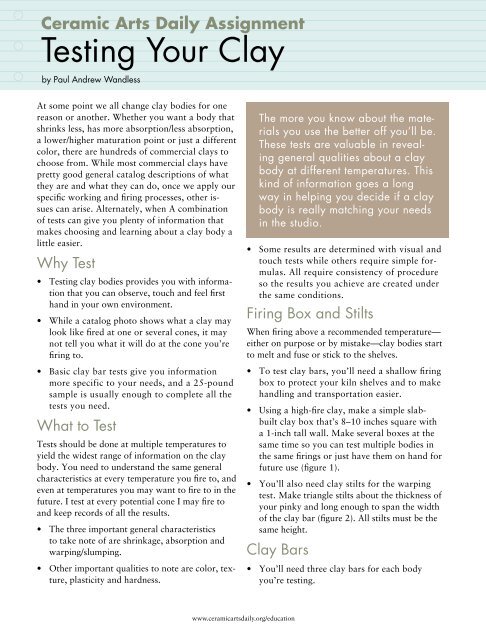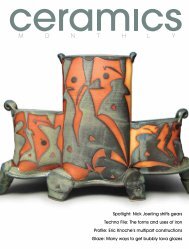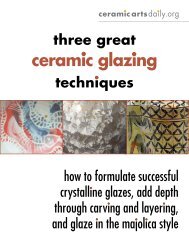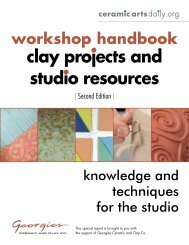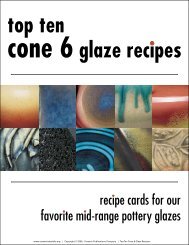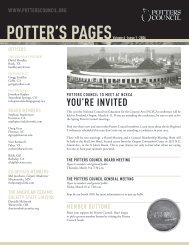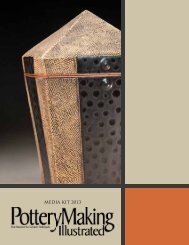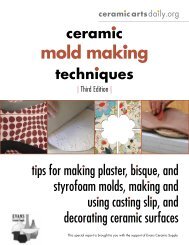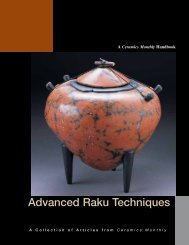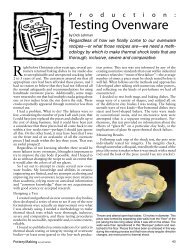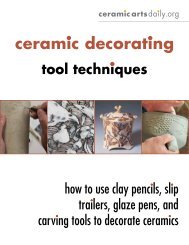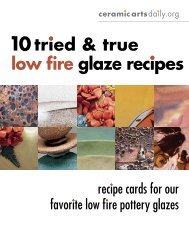Testing Your Clay - Ceramic Arts Daily
Testing Your Clay - Ceramic Arts Daily
Testing Your Clay - Ceramic Arts Daily
Create successful ePaper yourself
Turn your PDF publications into a flip-book with our unique Google optimized e-Paper software.
<strong>Ceramic</strong> <strong>Arts</strong> <strong>Daily</strong> Assignment<br />
<strong>Testing</strong> <strong>Your</strong> <strong>Clay</strong><br />
by Paul Andrew Wandless<br />
At some point we all change clay bodies for one<br />
reason or another. Whether you want a body that<br />
shrinks less, has more absorption/less absorption,<br />
a lower/higher maturation point or just a different<br />
color, there are hundreds of commercial clays to<br />
choose from. While most commercial clays have<br />
pretty good general catalog descriptions of what<br />
they are and what they can do, once we apply our<br />
specific working and firing processes, other issues<br />
can arise. Alternately, when A combination<br />
of tests can give you plenty of information that<br />
makes choosing and learning about a clay body a<br />
little easier.<br />
Why Test<br />
• <strong>Testing</strong> clay bodies provides you with information<br />
that you can observe, touch and feel first<br />
hand in your own environment.<br />
• While a catalog photo shows what a clay may<br />
look like fired at one or several cones, it may<br />
not tell you what it will do at the cone you’re<br />
firing to.<br />
• Basic clay bar tests give you information<br />
more specific to your needs, and a 25-pound<br />
sample is usually enough to complete all the<br />
tests you need.<br />
What to Test<br />
Tests should be done at multiple temperatures to<br />
yield the widest range of information on the clay<br />
body. You need to understand the same general<br />
characteristics at every temperature you fire to, and<br />
even at temperatures you may want to fire to in the<br />
future. I test at every potential cone I may fire to<br />
and keep records of all the results.<br />
• The three important general characteristics<br />
to take note of are shrinkage, absorption and<br />
warping/slumping.<br />
• Other important qualities to note are color, texture,<br />
plasticity and hardness.<br />
www.ceramicartsdaily.org/education<br />
The more you know about the materials<br />
you use the better off you’ll be.<br />
These tests are valuable in revealing<br />
general qualities about a clay<br />
body at different temperatures. This<br />
kind of information goes a long<br />
way in helping you decide if a clay<br />
body is really matching your needs<br />
in the studio.<br />
• Some results are determined with visual and<br />
touch tests while others require simple formulas.<br />
All require consistency of procedure<br />
so the results you achieve are created under<br />
the same conditions.<br />
Firing Box and Stilts<br />
When firing above a recommended temperature—<br />
either on purpose or by mistake—clay bodies start<br />
to melt and fuse or stick to the shelves.<br />
• To test clay bars, you’ll need a shallow firing<br />
box to protect your kiln shelves and to make<br />
handling and transportation easier.<br />
• Using a high-fire clay, make a simple slabbuilt<br />
clay box that’s 8–10 inches square with<br />
a 1-inch tall wall. Make several boxes at the<br />
same time so you can test multiple bodies in<br />
the same firings or just have them on hand for<br />
future use (figure 1).<br />
• You’ll also need clay stilts for the warping<br />
test. Make triangle stilts about the thickness of<br />
your pinky and long enough to span the width<br />
of the clay bar (figure 2). All stilts must be the<br />
same height.<br />
<strong>Clay</strong> Bars<br />
• You’ll need three clay bars for each body<br />
you’re testing.
• For consistency and accuracy of results, use the same<br />
dimensions for all your clay bars. While some tests<br />
yield correct results regardless of the bar dimensions,<br />
you can always rule out size and dimension as variables<br />
that could cause any irregularities.<br />
• Make ¼-inch-thick bars measuring 2 inches wide by 6<br />
inches long. If your work is thicker, make bars to match,<br />
but don’t exceed ½ inches in thickness.<br />
• After cutting the bars to size, draw a 10-cm-long line on<br />
one of them with a hash mark at each end. This will be<br />
used for a shrinkage test later (figure 3).<br />
• For the tests here, I’ve selected four bodies to test: two<br />
white bodies from Standard (#257 Grolleg Porcelain Cone<br />
8–10 and #181 White Stoneware Cone 6–10) and two<br />
from Amaco (#29 Brown Stone Earthenware Cone 06–04<br />
and #77 Terra Cotta <strong>Clay</strong> Cone 5). All four bodies have<br />
different characteristics at the temperatures to which I’m<br />
interested in firing them, and testing several bodies at the<br />
same time takes better advantage of each firing. Remember<br />
to write the clay number on the back of each tile.<br />
• Once all bars are cut and firing boxes are built, let them<br />
dry to bone dry. The boxes and bars can be stacked with<br />
newspaper layered in between and a board on top for a<br />
little weight to keep them from warping. It’s important<br />
that the firing boxes and clay bars stay flat while drying<br />
to assure accurate test results (figure 4).<br />
Before the Bisque<br />
• At the bone dry stage, visually examine the bars for a<br />
color change if any. Use a ruler to measure in centimeters<br />
the shrinkage line to see if it has changed from its original<br />
10 cm length. Record the results.<br />
• For each firing, place the bars side by side in the firing<br />
box, and place one of them on the triangle stilts. The<br />
stilts should be placed about ¼- to ½-inch in from the<br />
ends of the bar. If the stilts are too close, the bar may not<br />
warp or slump to its fullest potential.<br />
• The shrinkage bar and the other regular bar are simply<br />
placed in the bottom of the box.<br />
Firing<br />
• While the test firing can be done in any kiln, the results<br />
are most applicable if done in the same kiln used for<br />
your work.<br />
• Indicate in your notebook or worksheet if it’s an electric<br />
or gas kiln, oxidation or reduction firing, salt, wood,<br />
soda, etc.<br />
www.ceramicartsdaily.org/education<br />
Prepare test trays from high fire clay.<br />
Prepare triangular stilts to support bar.<br />
Four test bars with 10 cm. line.<br />
Dry trays and bars slowly and evenly.<br />
1<br />
2<br />
3<br />
4
• For best results, start firings at the lowest cone<br />
temperature and then progressively refire the<br />
bars at higher cones until the highest desired<br />
cone is reached.<br />
• A sample for progressive test firings for a cone<br />
10 clay body would be cone 06, cone 01, cone<br />
6 then finally cone 10.<br />
<strong>Clay</strong> Bar Tests<br />
The following traditional tests give a good range<br />
of basic information that helps you to better<br />
understand your clay body. Keep good records in<br />
your notebook so you’ll have the results for future<br />
reference. If there are other specific qualities, such<br />
as glaze fit or color effect, test for these also.<br />
• Warping/Slumping<br />
Visually examine for any warping or sagging<br />
movement in the center. Remove the bar from<br />
the stilts, turn it over and place it on a flat<br />
surface so the gap (if any) can be measured<br />
(figure 6). This test informs you at what temperature<br />
the walls may start to warp or deform<br />
or a plate may begin to slump. The information<br />
can be applied to the sculptural or structural<br />
applications of the clay body. An exact percentage<br />
for this is not as important as just knowing<br />
when the clay body starts to move.<br />
• Shrinkage Test<br />
Measure the length of the line in centimeters<br />
on the shrinkage bar (figure 7), and subtract it<br />
from 10 (based on the original 10 cm line). For<br />
example, 10 cm – 8.5 cm = 1.5 cm. An easy<br />
way to convert this result to a percentage is to<br />
move the decimal to the right one place, so 1.5<br />
cm means 15% shrinkage. Knowing the shrinkage<br />
rate helps in determining which glazes will<br />
fit the body and even which two bodies can be<br />
used together.<br />
• Absorption Test<br />
www.ceramicartsdaily.org/education<br />
Place one bar on stilts and two of them flat in the tray.<br />
After each firing, measure the amount of deflection.<br />
There are two types of tests that can determine<br />
the absorption of a clay body. One is a simple<br />
visual test and the other is a weight calculation.<br />
For the visual test, place a few drops of<br />
a liquid (like ink) on the surface of the bar to<br />
create a stain. Let it soak in for an hour then<br />
wash off the surface with water. The darker the<br />
stain, the more absorbent the clay. This is not Measure the 10 cm line to determine the shrinkage.<br />
5<br />
6<br />
7
an exact test, but it gives a quick and useful<br />
general result.<br />
The weight calculation test is more specific.<br />
Weigh the fired bar on a gram scale<br />
and record the result (figure 8). Soak the<br />
bar in water for 24 hours, pat dry, then<br />
weigh again and record the result. Subtract<br />
the first weight (dry bar) from the<br />
second weight (water soaked bar) to get<br />
the weight of the absorbed water. Divide<br />
the weight of the absorbed water by the<br />
original dry weight and move the decimal<br />
two places to the right to find the absorption<br />
rate.<br />
Example: Original bar weight of 4.2 grams<br />
is subtracted from soaked bar weight of 4.6<br />
grams giving you an absorbed water weight<br />
of .4 grams. Divide .4 by 4.2 which equals<br />
.095 making absorption 9.5%.<br />
• Color Test<br />
Visually examine a bar to see if there has<br />
been a color change (figure 9). The color<br />
change can sometimes be dramatic depending<br />
on the cone it was fired and is important<br />
for aesthetic purposes. It can also help<br />
you determine the best glazes to work visually<br />
on the surface.<br />
• Surface/Texture<br />
Visually examine the bar to determine if<br />
the surface has changed. Run your fingers<br />
across the bar to see if it’s the same,<br />
smoother or coarser. This information<br />
is important aesthetically and helps you<br />
determine if it meets your visual and<br />
tactile needs.<br />
• Hardness<br />
Using a nail, see if you can scratch the<br />
surface to see how hard or soft it is at<br />
the fired temperature. This test helps<br />
determine the surface durability at different<br />
temperatures.<br />
www.ceramicartsdaily.org/education<br />
Soak bars in water and weigh them after 24 hours.<br />
8<br />
Note the color of the clay after each firing. Here are four<br />
clays fired to cone 04 (top) and cone 7 (bottom).


